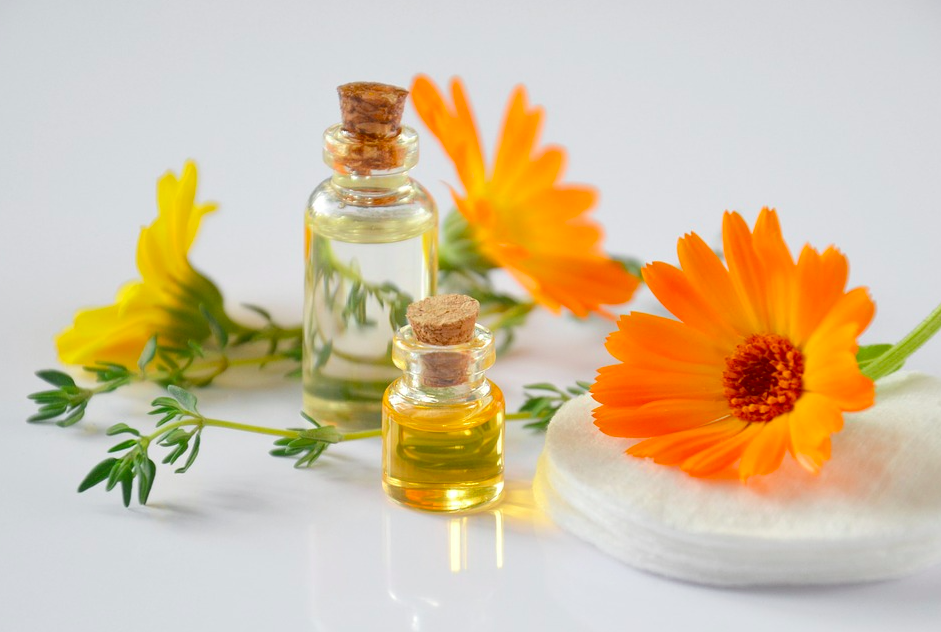The bushy plants have branched covered in fine hair that grows up to 2 feet long. The leaves are aromatic and the flowers are hues of bright orange or yellow. The plants bloom over a long period the flowers are famous amongst cultivators and florists.
For centuries, calendula has been used for a variety of culinary and medicinal purposes.
In ancient Greek, Roman and Indian cultures, calendula was used for its medicinal purposes as well as a colouring agent for fabrics, foods and cosmetics. Explore the various ways to include calendula in your daily life and its health benefits below.
Culinary Uses of Calendula

The culinary uses of the calendula plant include the use of petals, stems, and leaves. The petals of calendula flower are used to add colour to fresh salads, bread and cakes. They also add to add a mild peppery taste to soups. Calendula is often used as a saffron substitute, however, it contributes the colour more than the flavour. It is hence used as a natural colouring agent for butter and cakes.
Treat yourself and loved ones with the following homemade calendula food combinations.
- Fresh salad with herbs, calendula other edible flowers
- Soup with squash/ pumpkin & calendula
- Orange and calendula carrot cake
- Vanilla and calendula cupcakes
- Homemade pasta topped with calendula petals
- Savoury calendula cookies
- Topping on French Tart
- Calendula Tea Recipe:
You can make calendula tea by boiling calendula flowers in water in a ratio of a tablespoon of fresh flowers in a cup of water. Allow steeping for 9-10 minutes. You can add honey as per taste. Refrigerate for up to a week and enjoy this tea that also soothes internal mucous membranes.
Medicinal Uses of Calendula
Calendula flower is widely used in cosmetics. The essential oil obtained from its plant that is also used in perfumes. Calendula is also considered as a skin-healing herb by herbalists to heal and soothe skin conditions ranging as cuts, burns, rashes, acne and eczema. Calendula contains abundant antioxidants in its petals help heal skin wounds, rashes and burns by increasing blood flow to the affected area. Calendula is also consumed for its astringent, antiseptic, anti-fungal, anti-inflammatory and detox properties. It is known to be a bile production stimulator and menstrual regulator and should not be consumed during pregnancy. Calendula relieves muscle spasms and boosts a weakened immune system.
Calendula Benefits for Skin Care

- Calendula is an active ingredient in several diaper creams for babies.
- It is also used to make natural hand lotions and first-aid creams.
- It is useful in making a lotion for skin problems like eczema, psoriasis, acne, sunburn, wounds, athletes foot and ringworm.
- It can add to homemade DIY shampoo and foot soak
- A yellow dye obtained from the boiled flowers can also be used to add colour to hair.
- It’s lotion also promotes the healing of scrapes, bites and stings.
- Herbalists confirm calendula tea soothes sore throats and treat ulcers. It also helps in healing urinary tract infections.
- You can make a moisturising body cream with Calendula, oats & honey body cream or body scrub with and calendula and sugar for gentle exfoliation.
- Calendula extract is also useful in making facial toner and herbal balm.
- Calendula mouthwash is effective for bleeding gums.
- It is also consumed for treating fevers and chronic infections.
How to Grow Calendula Flowers at home
Calendula is an annual flower. It self-seeds easily so the plant will grow on its once in the next season. It can survive the winter in mild climates. Calendula is often planted as a companion plant to tomatoes and potatoes to help deter insect pests and can be easily grown in the comfort of your home.
Growing Calendula Flowers in Pots
Calendula flowers can be easily grown in containers and pots. Feel free to decorate balcony, kitchen and office spaces with calendula flower pots as long as the spot receives enough sunlight.
- Take a pot containing plenty of drainage holes to avoid soggy feet
- Although it can grow in partial shade, calendula prefers sunshine. Therefore, place the pot in a spot receiving 6-8 hours of sunlight.
- The plant prefers loose and rich soil amended with compost with a pH of 6-7.
- Start the seeds indoors. Avoid transplanting seedlings and transfer the plant to pots only once they have reached the budding stage. You can also sow the seeds directly in the pot.
- Calendula needs plenty of water. Water the pots regularly and mulch the soil. Avoid overwatering, but supply 1 to 11⁄2 inches of water per week in mid-summer for optimal growth.
- Growing calendula in pots will attract butterflies. Remove old flowers (deadheading) to encourage re-bloom.
- Gather calendula flowers late in the morning. They are fully open then and the dew has dried. Pick the complete flower at full bloom. Flowers will re-bloom in about 2 weeks. You can also collect seeds when fully mature and dry.
You can buy Open Pollinated, Non-GMO and Non-Hybrid calendula Officinalis blossoms seeds at AllThatGrows. Recommended varieties to grow in pots are below:
1. Calendula Officinalis yellow seeds
2. Calendula Officinalis gitana mixed seeds
3. Calendula Officinalis double mixed seeds
Drying Calendula flowers

Calendula flowers contain a high amount of moisture and oil content. Pick flowers heads early in the morning before the volatile oils evaporate.
Air-dry the petals and preserve in an airtight container out of direct sunlight. Use within a year.
Using dried calendula flowers
Enjoy dried calendula flowers in herbal teas, oil infusions, scrubs, lotions and tinctures for up to a year to make the best of their culinary and medicinal benefits as discussed earlier in the blog.


 Sign In
Sign In











Let us know your feedback
* Comments must be approved before being displayed.